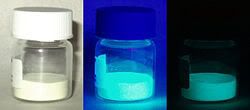Phosphorescence
 Phosphorescence is a specific type of photoluminescence related to fluorescence. Unlike fluorescence, a phosphorescent material does not immediately re-emit the radiation it absorbs. The slower time scales of the re-emission are associated with "forbidden" energy state transitions in quantum mechanics. As these transitions occur less often in certain materials, absorbed radiation may be re-emitted at a lower intensity for up to several hours.
Phosphorescence is a specific type of photoluminescence related to fluorescence. Unlike fluorescence, a phosphorescent material does not immediately re-emit the radiation it absorbs. The slower time scales of the re-emission are associated with "forbidden" energy state transitions in quantum mechanics. As these transitions occur less often in certain materials, absorbed radiation may be re-emitted at a lower intensity for up to several hours.In simpler terms, phosphorescence is a process in which energy absorbed by a substance is released relatively slowly in the form of light. This is in some cases the mechanism used for "glow-in-the-dark" materials which are "charged" by exposure to light. Unlike the relatively swift reactions in a common fluorescent tube, phosphorescent materials used for these materials absorb the energy and "store" it for a longer time as the subatomic reactions required to re-emit the light occur less often.
Most photoluminescent events, in which a chemical substrate absorbs and then re-emits a photon of light, are fast, on the order of 10 nanoseconds. However, for light to be absorbed and emitted at these fast time scales, the energy of the photons involved (i.e. the wavelength of the light) must be carefully tuned according to the rules of quantum mechanics to match the available energy states and allowed transitions of the substrate. In the special case of phosphorescence, the absorbed photon energy undergoes an unusual intersystem crossing into an energy state of higher spin multiplicity (see term symbol), usually a triplet state. As a result, the energy can become trapped in the triplet state with only quantum mechanically "forbidden" transitions available to return to the lower energy state. These transistions, although "forbidden", will still occur but are kinetically unfavored and thus progress at significantly slower time scales. Most phosphorescent compounds are still relatively fast emitters, with triplet lifetimes on the order of milliseconds. However, some compounds have triplet lifetimes up to minutes or even hours, allowing these substances to effectively store light energy in the form of very slowly degrading excited electron states. If the phosphorescent quantum yield is high, these substances will release significant amounts of light over long time scales, creating so-called "glow-in-the-dark" materials.
Common pigments used in phosphorescent materials include zinc sulfide and strontium aluminate. Use of zinc sulfide for safety related products dates back to the 1930s. The study of phosphorescent materials led to the discovery of radioactivity in 1896.
Taken from Wikipedia

0 Comments:
Post a Comment
Subscribe to Post Comments [Atom]
<< Home